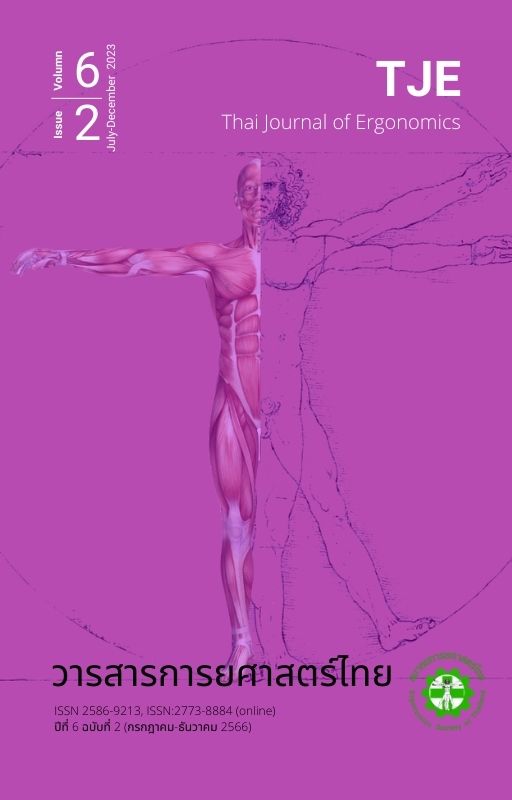The immediate effects of biofeedback training with real-time weight distribution sensor in people with asymmetrical sitting weight-bearing
Main Article Content
Abstract
The purpose of this study was to investigated the immediate effects of biofeedback training with real-time weight distribution sensor in subjects with asymmetric weight-bearing in sitting. Twenty-six participants with asymmetrical weight-bearing were divided into 2 groups. Before the test, the weight distribution on the left and right buttocks was recorded. The subjects of experiment group were then given biofeedback training with a real-time weight distribution sensor. Whereas, the control group were got to sit and watch the video. The test duration was 15 minutes. After the training, the weighting distributions were recorded. The ratio of weight distribution between the left and right buttocks was used to analyze the relationship before and after training in each group and the differences between groups. The results showed that the mean that ratio before training was 1.16 (SD=0.06) and after training was 1.09 (SD=0.09) and there was a statistically significant difference between before and after training at a significance level of p=0.049 in the experimental group. The results of this study showed that biofeedback training with a real-time weight distribution sensor can improve weight bearing in sitting more symmetrical.
Article Details

This work is licensed under a Creative Commons Attribution-NonCommercial-NoDerivatives 4.0 International License.
References
Arora SN, Khatri S. Prevalence of work-related musculoskeletal disorders in sitting professionals. Int J Community Med Public Health 2022;9(2):892-5.
Park IS. Development of a system for measurement on sitting postural bias and biomechanical characteristics analysis of patients with pelvic asymmetry. [Dissertation] Jeonbuk University; 2013.
Théroux J, Stomski N, Hodgetts CJ, Ballard A, Khadra C, Le May S, et al. Prevalence of low back pain in adolescents with idiopathic scoliosis: a systematic review. Chiropr Man Therap 2017;25:10.
Anker LC, Weerdesteyn V, van Nes IJ, Nienhuis B, Straatman H, Geurts AC. The relation between postural stability and weight distribution in healthy subjects. Gait Posture 2008;27(3):471-7.
Ribeiro DC, Sole G, Abbott JH, Milosavljevic S. Extrinsic feedback and management of low back pain: a critical review of the literature. Man Ther 2011;16(3):231-9.
Kuo YL, Wang PS, Ko PY, Huang KY, Tsai YJ. Immediate effects of real-time postural biofeedback on spinal posture, muscle activity, and perceived pain severity in adults with neck pain. Gait Posture 2019;67:187-93.
O'Sullivan K, O'Sullivan L, O'Sullivan P, Dankaerts W. Investigating the effect of real-time spinal postural biofeedback on seated discomfort in people with non-specific chronic low back pain. Ergonomics 2013;56(8):1315-25.
Yoo WG, Park SY. Effects of posture-related auditory cueing (PAC) program on muscles activities and kinematics of the neck and trunk during computer work. Work 2015;50(2):187-91.
Na YM, Lee GC, Lim KB, Lee HJ. Effects of Sitting Balance Using Visuo-perceptual Biofeedback Training in Stroke Patients. Ann Rehabil Med 2003;27(2):164-72.
Pellegrino L, Giannoni P, Marinelli L, Casadio M. Effects of continuous visual feedback during sitting balance training in chronic stroke survivors. J Neuroeng Rehabil 2017;14(1):107.
Lee SW, Shin DC, Song CH. The effects of visual feedback training on sitting balance ability and visual perception of patients with chronic stroke. J Phys Ther Sci 2013;25(5):635-9.
Akkarakittichoke N, Janwantanakul P. Seat pressure distribution characteristics during 1 hour sitting in office workers with and without chronic low back pain. Saf Health Work. 2017;8(2):212-9.
Cho MS, Park KN, Choung SD, Kwon OY. Effect of visual biofeedback training in real time on buttock pressure and pelvic tilting angles of hemiplegic patients during sitting. Phys Ther Korea 2017;24(2):66-75.
Caromano FA, de Amorim CA, de Fátima Rebelo C, Contesini AM, Fávero FM, Frutuoso JR, et al. Prolonged sitting and physical discomfort in university students. Acta Fisiátrica. 2015;22(4):176-80.
Kuiken TA, Lowery MM, Stoykov NS. The effect of subcutaneous fat on myoelectric signal amplitude and cross-talk. Prosthet Orthot Int 2003;27(1):48-54.
Jung K, Kim Y, Chung Y, Hwang S. Weight-shift training improves trunk control, proprioception, and balance in patients with chronic hemiparetic stroke. Tohoku J Exp Med. 2014;232(3):195-9.
Tsaklis PV, Grooten WJ, Franzén E. Effects of weight-shift training on balance control and weight distribution in chronic stroke: a pilot study. Top Stroke Rehabil 2012;19(1):23-31.
Kim MK, Ji SG, Cha HG. The effect of mirror therapy on balance ability of subacute stroke patients. Hong Kong Physiother J 2016;34:27-32.
Drużbicki M, Guzik A, Przysada G, Kwolek A, Brzozowska-Magoń A. Efficacy of gait training using a treadmill with and without visual biofeedback in patients after stroke: A randomized study. J Rehabil Med 2015;47(5):419-25.
Alwhaibi RM, Alsakhawi RS, ElKholi SM. Augmented biofeedback training with physical therapy improves visual-motor integration, visual perception, and motor coordination in children with spastic hemiplegic cerebral palsy: a randomised control trial. Phys Occup Ther Pediatr 2020;40(2):134-51.


